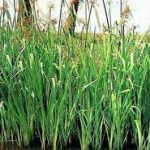Scirpus grossus
Uses
India: the Bhils collect the plant’s roots at the beginning of the dry season from Nal tank (northwest area of Dholka Taluka). Threshing removes adhering clay. The outer fibers are burnt in a fire of their own grasses [sic], and again threshed – a process which is repeated. The roots are then ground into flour from which bread is prepared. The root is toxic and must be processed as described [sic]. There is some conflict here, as the root is also reported eaten uncooked [vide. Pathak]. (Kumaon region, Western Himalayas): starchy roots eaten raw or cooked.
Additional Information
- Name Authority:
- L. f.
- Vernaculars:
- India: Bid
- Misc:
- Chemical composition: (after Paton & Dunlop) (grams per 100g): Protein = 4.12g [Pathak gives 11.81]. Fat = 1.0g. Carbohydrate (soluble) = 76.18g. Fibre = 6.80g. Ash = 3.40g. Water = 8.50g. Calories = 338.
